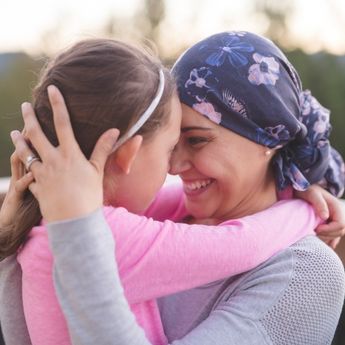By continuing to use our site, you consent to the processing of cookies, user data (location information, type and version of the OS, the type and version of the browser, the type of device and the resolution of its screen, the source of where the user came from, from which site or for what advertisement, language OS and Browser, which pages are opened and to which buttons the user presses, ip-address) for the purpose of site functioning, retargeting and statistical surveys and reviews. If you do not want your data to be processed, please leave the site.
The Voice of People With Breast Cancer
Information
Breast Cancer Basics
Subtypes of Breast Cancer
HER2 positive (HER2+)
HER2 positive breast cancer is caused by too much (an overexpression) of the human epidermal growth factor receptor 2 (HER2) protein, which helps regulate cell growth. Excess HER2 can lead to uncontrolled cell division and tumour growth.
Approximately 10-20% of breast cancers are HER2 positive. These cancers tend to grow more aggressively than HER2 negative ones but respond well to HER2-targeted therapies. Thanks to these treatments, people with HER2 positive breast cancer are living longer and with better outcomes than in the past.
How is HER2 Status Determined?
Your pathology report determines whether your breast cancer is:
- HER2 positive
- HER2-low
- HER2 negative
Two tests are commonly used to check the HER2 status of a person’s cancer:
- Fluorescence In Situ Hybridization (FISH) test: Measures how many HER2 gene copies are in the breast cancer cell:
- Gives a positive or negative result
- Immunohistochemistry (IHC) test: Measures HER2 protein levels and assigns a score:
- 0 = HER2 negative
- 1+ to 2+ (FISH-negative) = HER2-low
- 2+ (FISH-positive) or 3+ = HER2 positive
Why retesting matters
HER2 status can change over time. Some HER2 positive cancers may become HER2 negative and vice versa. If breast cancer recurs, a biopsy may be needed to recheck HER2 status and adjust treatment accordingly.
What is HER2-Low Breast Cancer?
HER2-low breast cancer has lower levels of HER2 protein but not enough to be classified as HER2 positive. Unlike HER2 positive cancers, these tumours do not primarily rely on HER2 for growth.
HER2-low breast cancer is typically defined as an IHC score of 1+ or 2+ with a negative FISH test. It accounts for about 50-55% of breast cancer cases and is more common in hormone receptor (HR) positive breast cancers.
The distinction between HER2 positive and HER2-low is relatively new, primarily applying to metastatic cases. Some people with HER2-low metastatic breast cancer may now qualify for targeted treatments.
Systemic Treatments for HER2 Positive or HER2-Low Breast Cancer
Knowing your HER2 status helps determine if targeted systemic therapies may be used to treat your cancer. These treatments work throughout the body and are given as pills or IV infusions.
HER2-Targeted Therapy
HER2-targeted therapies attack HER2 positive cancer cells, slowing tumour growth while lessening damage to healthy tissue. These include monoclonal antibodies and antibody-drug conjugates (ADCs).
- Monoclonal Antibodies: Lab-made proteins that bind to HER2 receptors, blocking tumour growth and helping the immune system destroy cancer cells. Examples include:
- Antibody-Drug Conjugates (ADCs): Combines an antibody with chemotherapy delivering it directly to the cancer cells while sparing healthy tissue.
Chemotherapy
Chemotherapy kills fast-growing cells including cancer cells. It may also affect healthy cells, leading to side effects like hair loss.
Use our PatientPath tool to get information tailored to your diagnosis and visit the "Making Treatment Decisions" section to learn more.
Resources and Support
- Questions & Experts: Medical Oncologist, Dr. Karen Gelmon, Answers Your Questions About HER2+ Breast Cancer
- Advocacy Guide: Increasing Research on HER2-Low Breast Cancer
- MedSearch: Information on HER2+ Treatments
Related reading from Our Voices Blog:
Additional resources from partner organizations:
- Breastcancer.org: HER2 Status
- Living Beyond Breast Cancer: HER2-positive or HER2-low breast cancer
- Private Facebook Group: HER2 Positive Breast Cancer Support and Awareness Group
Medical Review by Roochi Arora, MD, FRCPC, August 2025
- References
-
American Cancer Society. (2025). Breast cancer HER2 status. Cancer.org. https://www.cancer.org/cancer/types/
breast-cancer/understanding-a-breast-cancer-diagnosis/breast-cancer-her2-status.htmlCanadian Breast Cancer Network. (2022). Breast cancer and you: A guide for people living with breast cancer [PDF]. https://cbcn.ca/web/default/files/public/
Reports/Breast%20Cancer%20and%20You_
ENG_edit_web.pdfCanadian Breast Cancer Network. (2023). HER2-low advocacy guide [PDF]. https://www.cbcn.ca/web/default/files/
public/Reports/HER2-Low%20Advocacy%20Guide.pdfDePolo, J. (2025). HER2 status. Breastcancer.org. https://www.breastcancer.org/pathology-report/her2-status
HER2 Positive Breast Cancer Support and Awareness Group. (n.d.). Home [Facebook page]. Facebook. Retrieved February 12, 2025, from https://www.facebook.com/groups/
210252712417646.Living Beyond Breast Cancer. (2024). HER2-positive or HER2-low breast cancer. https://www.lbbc.org/about-breast-cancer/types-breast-cancer/her2-positive
Mark, C., Lee, J. S., Cui, X., & Yuan, Y. (2023). Antibody-drug conjugates in breast cancer: Current status and future directions. International Journal of Molecular Sciences, 24(18), 13726. https://doi.org/10.3390/ijms241813726
National Cancer Institute. (2024). Cancer stat facts: Female breast cancer subtypes. National Heath Institute. https://seer.cancer.gov/statfacts/html/
breast-subtypes.htmlShirman, Y., Lubovsky, S., & Shai, A. (2023). HER2-low breast cancer: Current landscape and future prospects. Breast Cancer (Dove Medical Press), 15, 605–616. https://doi.org/10.2147/BCTT.S366122
SHARE




